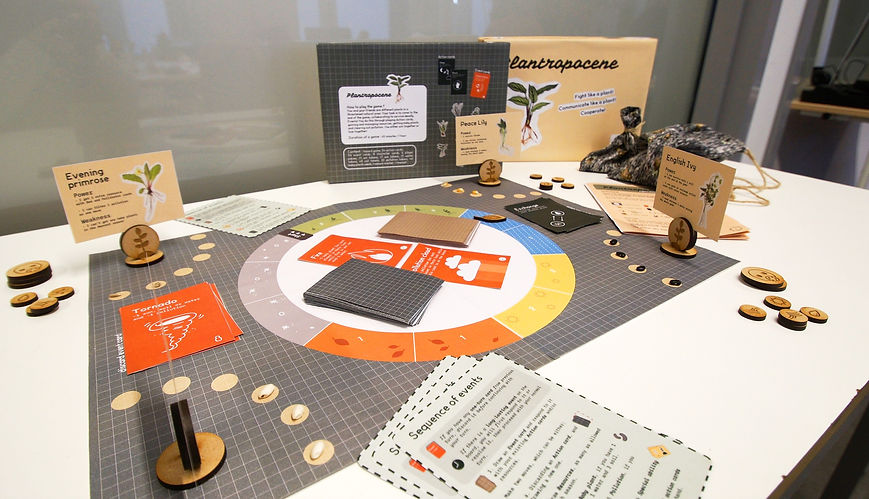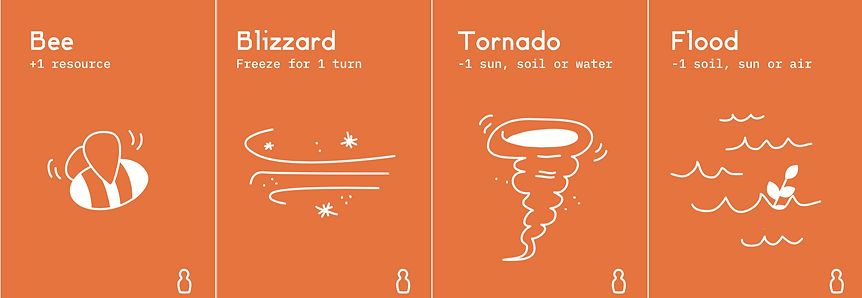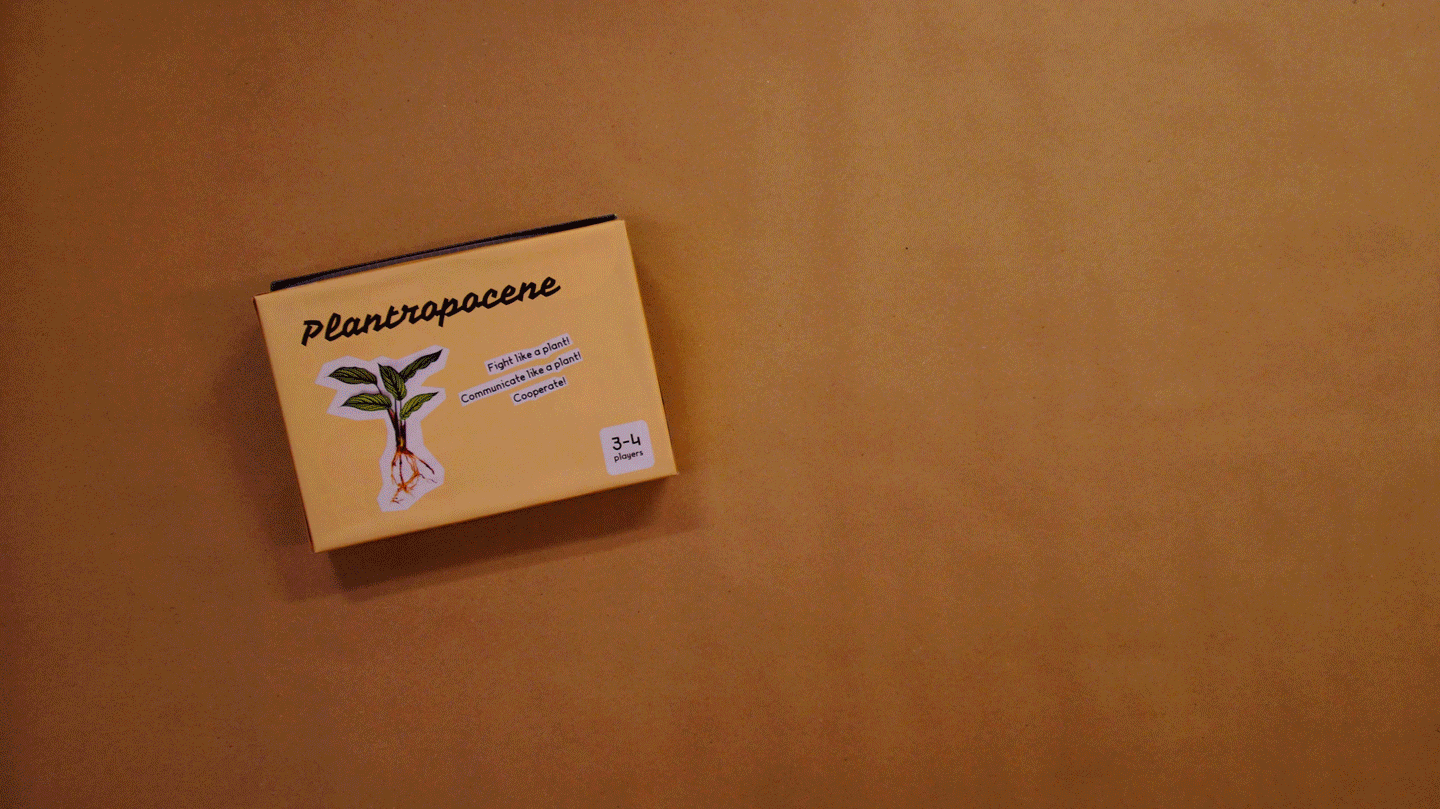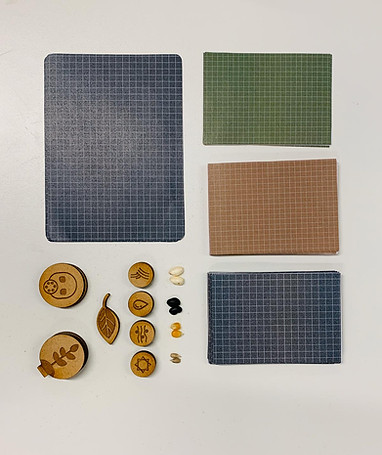
MY ROLE
Concept Research,
Concept development,
UI design,
Numerical rules design,
Prototyping,
User-Testing,
Design iteration,
Design report
DURATION
Two months from October 2019 - January 2020
TOOLS
Illustration
Adobe UX
Paper prototyping
User testing
TEAM
Chang Cai
Emelie Larsson
Yenika Castillo Munoz
Maureen Troel
Plantropocene
Board Game Design
Results
Plantropocene is a collaborative board game for 4-6 players. We focused on creating an interactive process that play experience could help the participants/players to gain an understanding of our living environment from the perspective of plants, and reflect on human behaviours.
The intentionally critical play experience can reveal the attitudes, political values, and expressions.
The underlining value of Plantropocene is located in the possible educational outcomes where players can learn about the attributions of the plants.

Plantropocene started as an internal experiment at the design group, which eventually became a standalone board game. This game has attracted professional gamers, interaction designers, environmentalist etc. to discuss the possibilities and the opportunities in the field of game design and innovation tools for tackling social and environmental issues.
There is social value in playing together, we wanted to create a critical play experience that players can get inspired and discuss the relevant topics automatically.
To be sure our game can create critical reflections among players, we designed our process based on RTD(Research Through Design) and involved playtesting in the early stage of the design process.
We were prototyping, playtesting, validating every step of the way with the input from real players. Our starting point was building a story that can mimic plants living situation in reality.
"Play and games have been part of human life for centuries"
-
How to employ game as a medium for building up a theoretical frame of critical play?
-
How to design the game metrics to enable the game can reflect and create cultures and even functioning as a tool for social changes?
-
What measurements in the game experience design that can trigger player reflects on a specific topic?
Challenges


The research shows that biodiversity is lost 100 times faster than in natural rate according to human activities, and the mass conversation about extinction focuses on animals.

With the research on the devastating consequence of climate crisis, we find out that mass attention is focusing on the extinction of animals. However, plants are intelligent and sentient and plays an essential role in supporting the ecosystem. So we set up the goal of game experience is that players can learn about the plants living conditions and how human activities threaten their surviving.
Focusing on the play experience touchpoints, we designed the storyline, board game concepts and tested play experience of those concepts.




Having gone through a series of iteration we landed on a turn-based, collaborative role play game, 3-4 players can play together and they either win or lose together. In the game, players adopt the role of plants and have certain strengths and weakness. These are to be used to build common strategies to survive.
Critical play aims that playful experience can also create critical thinking. Game design is actually about designing the rules and system that can stimulate an emotional response in players. So in the game Plantropocene, the game mechanism should offer players a play environment where the scenarios and options can make the players interested in critiquing.
"Event card" and "Action card" were set to formulate the game storyline. With the purpose of critical play - providing players with a holistic viewpoint, it is essential to keep scenarios' authenticities and varieties. Keeping the diversities of the scenarios is a challenge.
Since the winning and losing condition is determined by 4 game elements' status at the end of the game, having a basic game system is a base for the numerical rules design.

Characters

Action Card
Event Card
Gameplay Introduction
“The game evolves in 12 rounds, each player has a turn in each round. These rounds are divided by seasons, which have a base rule of how many resources the players can draw on each of them. Each turn, the players draw Event cards, that cause adverse effects for them, like taking away resources or giving pollution. These events might be natural or human-caused catastrophes, but also friendly happenings like rain, compost or pollinators. In order to survive and thrive, the players can use action cards, draw resources and manage them and get baby plants, and at all times they have to get rid of pollution.”

Playtesting within the design group, gamers and with the people who are not familiar with board games has contributed to the understanding of play experience. What types of play experience can form a foundation for critical play?


We found out that multiple emotions have been triggered in the gameplay. For example, happy, relief, frustration, anger, scared, nervous etc.
Categorizing the game content and defining the emotions. Emotions are tightly bound with scenarios, the shifting of the scene can result in varied emotions.
When we categorized the game content, we better interpret the scenarios logically and we understood the possible emotions in the game.
Since the randomized “Event cards” rule mainly the storyline, we categorized its content for getting the picture of emotions that the designated narratives may trigger.

While finding out what game mechanics and how they were triggering the emotions was important.
Based on the classification, we realized that the game Plantropocene has 6 “Event cards” in a positive direction, and 13 cards in a negative direction. The number of cards classified under the negative direction was double the number of positive cards. To balance the tension of the game atmosphere we needed to understand the probability of occurrence of different types of events. The outcomes of the categorizing and the counting helped us gaining an intuitive understanding of the game elements and current structure, which lay a foundation for calculating and finetuning numerical rules in the next step.

A game is a system; it has conflicts which are artificial (Flanagan, 2009, p. 7). Experiencing conflicts is how players access to different emotions. Building confrontation is essential, especially for critical game design. It means the game rules, the options they provide, and the winning and losing conditions can evoke controversies or create dilemmas in the game. The calculations divided into three steps:
1. Analyze the winning and losing conditions and figure out the main game components.
2. Based on the content of the game components, analyze the rules for gaining and losing resources.
Gain insights into understanding the complexity of the game system.
3. Analyze the impact level of cards and calculate the card frequencies.
The information on the card mirrors the real-world in a symbolic way. In this level, some instructions have a substantial impact, and some are slight. The impact level of cards adjusts the tension in the game. We were studying the cards’ impact level before calculating the frequencies.


Here is the research report about numerical rules design: https://docs.google.com/document/d/1ww_BMVSVenlkxuRIgG0K70iN_ebjs0t_HqaLMmuf03c/edit
Balancing the challenges and players’ mechanics